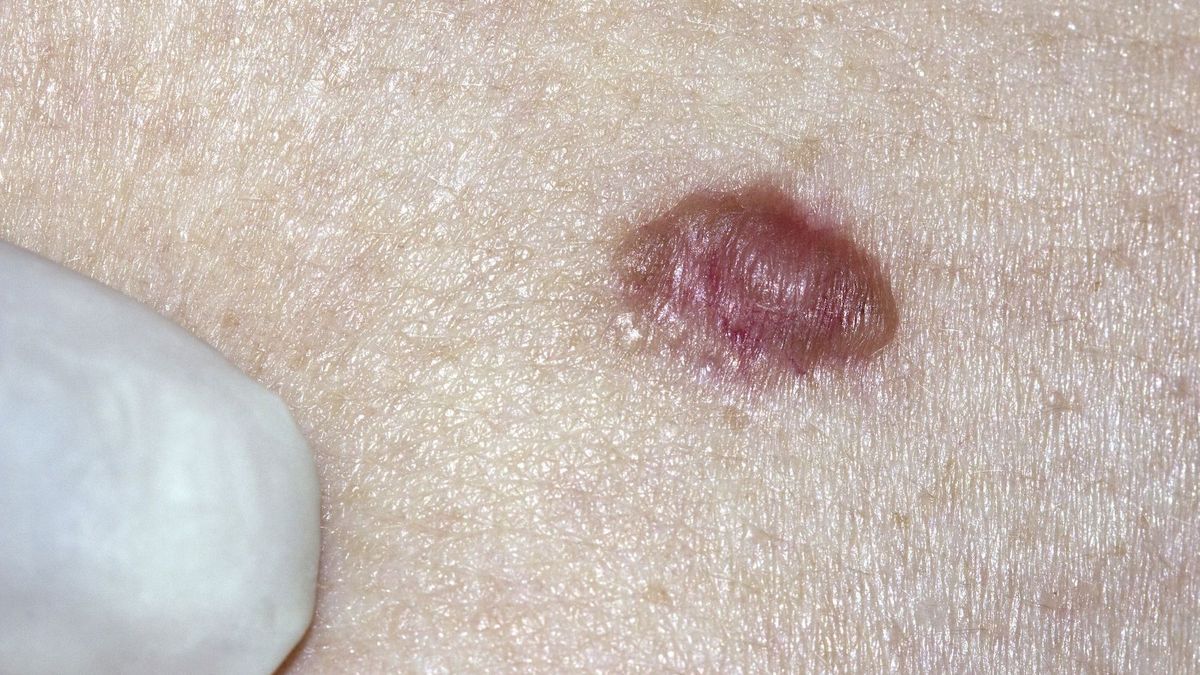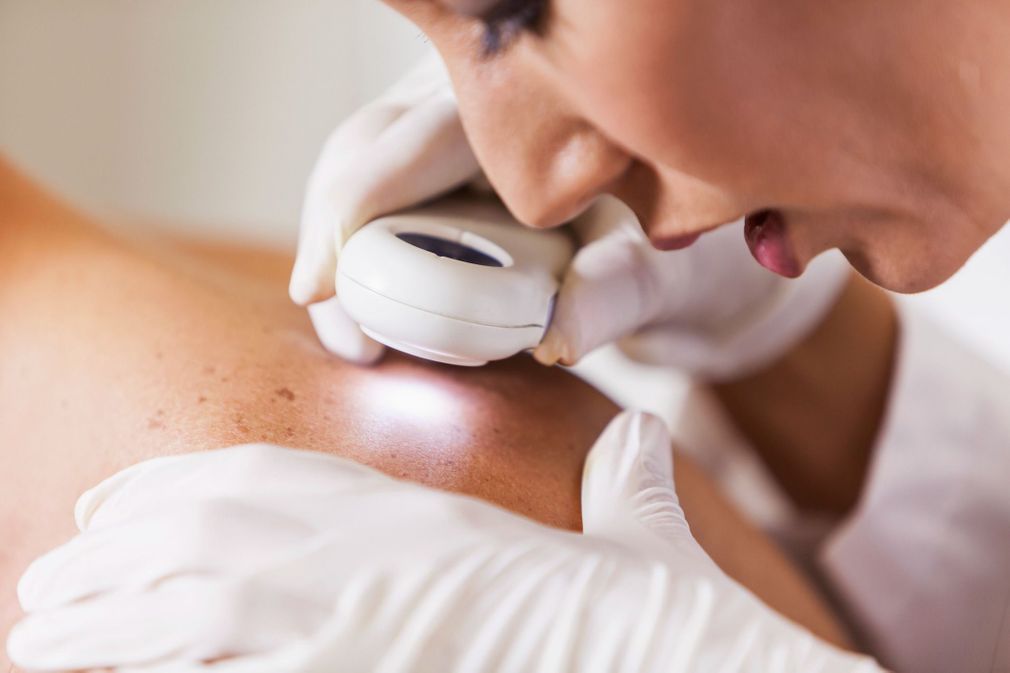
Basal cell carcinoma or BCC is a common skin cancer. It is sometimes detected incidentally during a clinical skin examination. Treatment depends on the biopsy and its shape. Recovery is complete if it is treated early. The best way to prevent basal cell carcinoma is to protect yourself from the sun's rays.
Definition: what is basal cell carcinoma?
The carcinome basocellulaire (cbc) or basocellulaire epithelioma is a skin cancer that develops in skin cells, in the epidermis (most superficial layer). The basal cells (or basal layer) present in the deepest part of the epidermis proliferate and accumulate, until they form a tumor. “The Basal cell carcinoma is the most frequently diagnosed skin cancer in the city., explains Doctor Caroline Pouget, dermatologist. “It affects adults and generally appears around the age of 50..
What are the affected areas?
Basal cell carcinoma mainly affects parts of the body that have been exposed to the sun, such as the neckline, shoulders or thorax. The face is also affected, especially the nose or around the ears.
Is it still serious, is it still cancerous?
The cbc is slow evolving, it is rarely fatal. “This cancer does not metastasize, but it can infiltrate the skin and create damage if we allow it to progress in the affected area. This is why we systematically treat it when the diagnosis is made.” the dermatologist informs us. “Even if it is not the cancer which presents the most severe forms, the patient is not protected from a recurrence. On the other hand, these are cancer cells and basal cell carcinoma always requires the establishment of a treatment”.
What are the differences with squamous cell carcinoma?
Squamous cell carcinoma is one of the squamous cell carcinomas. Its degree of invasiveness is greater and its grade is a little more severe; we remove it with safety margins to avoid secondary expansion. The squamous cell carcinoma Rather, it appears as red, irregular patches, craters or skin lesions that do not heal. The treatment for this skin cancer is surgical.
What causes basal cell carcinoma?
Sun exposure is the main cause of cbc. “It is mainly sunburns between the ages of 0 and 19 that increase the risks. Subsequent exposure to the sun can be aggravating.
People with a cbc risky terrain are those :
- With a phototype clair ;
- With some medical history of skin cancer ;
- Who are exposed to artificial UV rays in the cabin.
The skin is then exposed to damage. Children and adolescents are at risk. You must be very vigilant about your exposure to the sun and, above all, respect protective measures.
What are the symptoms: how does it start?
The basal cell carcinoma or cbc can take several forms. At first, it appears as a flesh-colored, slightly pearly or dark pimple (like a light mole).
Superficial basal cell carcinoma
The superficial cbc manifests itself as a shallow lesion on the surface of the epidermis. It looks like a small depression in the skin or a lesion lighter than the surrounding skin. It can also be a plaque with a scaly and peeling appearance.
Nodular basal cell carcinoma
In the case of a nodular cbc, the lesion takes the form of a small raised nodule. It is often surrounded by blood vessels called telangiectasias.
Infiltrating basal cell carcinoma
In this type of BCC, the skin lesion resembles a non-uniform scar, which most often appears on the nose or around the ears. It is sometimes visible on the thorax, at the shoulders or neckline. This infiltrative form may also appear as red patches.
What are the diagnostic methods?
“Basal cell carcinoma is very common, but little known to the general public. We often see it in consultation and we can find it during a classic skin check”, informs us Dr. Pouget.
The clinical examination, using a magnifying optical device, as well as medical questioning of the patient, to find out the patient's history of sun exposure can therefore be sufficient to diagnose BCC. A biopsy (performed under local anesthesia) with an anatomopathological or microscopic examination is sometimes recommended for define the type of basal cell carcinoma (superficial, nodular or infiltrative).
Treatment of basal cell carcinoma: how to cure it?
Two types of treatments are indicated in cases of basal cell carcinoma or BCC. The treatment chosen by the doctor depends on the results of the biopsy. It may be medicine (cream) or surgery with or without safety margin to remove cancer cells.
Topical cream
If the shape is superficial, a ALDARA type cream is prescribed by the dermatologist. It is a modulating drug, which acts on the body's immune response. This medicine inhibits the proliferation of cells that cause the tumor.
Surgery
In the event of infiltrating basal cell carcinoma or lesions in areas at risk, the surgery is often proposed. Different techniques exist and some are practiced in a hospital environment for the best possible skin reconstruction, particularly on the face. Surgery is commonly used and several techniques are possible, such as surgical excision or the Mohs surgery.
Should it be treated urgently?
“Treatment for BCC is not a medical emergencyindicates the dermatologist. But once diagnosed, it must be removed, ideally within two months. Squamous cell carcinomas or melanomas must, on the other hand, be treated urgently, because they have consequences on the rest of the body.
Can basal cell carcinoma be prevented?
The prevention of this skin cancer goes through some protection measures from the sun's rays to limit risky behavior:
- The use of Solar cream : “in patients treated for this carcinoma, sun protection is prescribed” ;
- Wearing a cap or a hat wide-brimmed (the scalp can be affected by the cbc);
- The port of sunglasses and a tee-shirt protection ;
- Do not expose yourself to UV rays from cabins ;
- Do not expose yourself to the sun between 11:00 a.m. and 4:00 p.m. ;
- Consult your dermatologist once a year in case of medical or family history, burns or significant sunburn to carry out a basal cell carcinoma screening.
From the age of 50, even without a history, it is recommended to make an annual visit to your dermatologist for a complete skin examination. At any age, as soon as suspicious symptoms appear or at the slightest doubt, it is advisable to consult your doctor.

